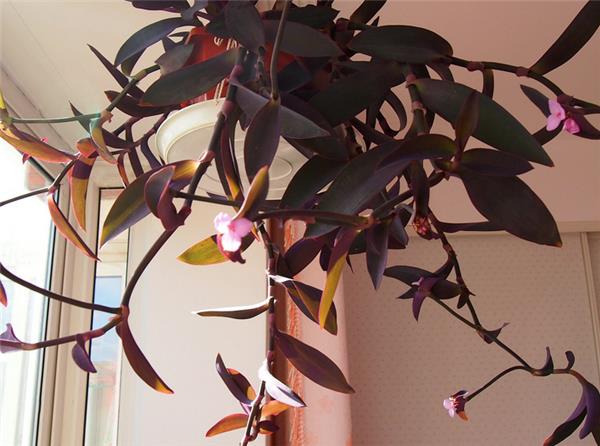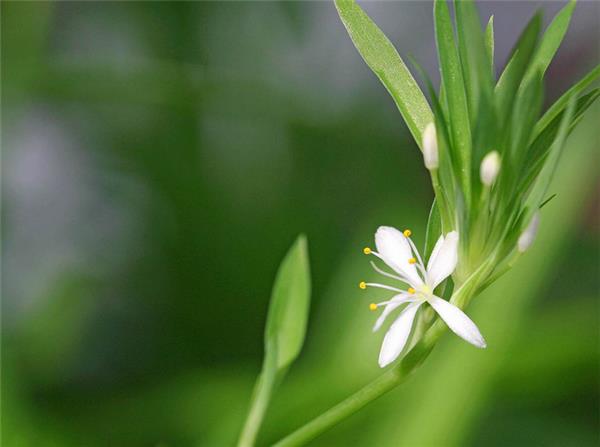Nursing skills of cultivating Cymbidium in the air
Hanging orchid, also known as weeping pot grass, laurel orchid, hook orchid, folding crane orchid, Western Europe, also known as spider grass or aircraft grass, originated in South Africa. Perennial evergreen herbs of the family Liliaceae. The roots are fleshy and the leaves are slender, like orchids. The stolon extracted from the axil of the orchid leaf is long, rigid and soft; the leaves clustered at the top of the stem droop outward from the basin and flutter with the wind, resembling a crane that spreads its wings, so the ancient hanging orchid is known as folding crane. So how much do you know about hanging orchids? Let's take a look.

First, the introduction of hanging orchids
Cymbidium, with clusters of leaves, looks like flowers, evergreen all the year round, is a famous foliage flower, and is known as "aerial flowers". According to the research, the hanging orchid has the function of absorbing toxic gases, and there is a pot of hanging orchids in the general room. the formaldehyde emitted by smoking and building materials in the air can be completely absorbed, play a role in purifying the air, and can also play a role in protecting the human body. The root of Cymbidium and the whole grass can be used as medicine, which has the effects of clearing lung, relieving cough, cooling blood, stopping bleeding and so on. Cymbidium is a perennial herb with slender and drooping branches, small white flowers in summer and yellow stamens, which can be watched in pots. Character identification fibrous root cylindrical fusiform, with short rhizomes. Complete leaves strip to strip-lanceolate, long 20~30cm, wide 1~2cm in diameter, apex acuminate, base clasping; dark green in color, some with yellow longitudinal stripes or margin yellow; hard. Some still have scape and inflorescence, its gas is faint and its taste is light. Hanging orchids like warm, moist, semi-overcast environment. It has strong adaptability, drought tolerance, but not cold resistance, strict requirements on the soil, and generally grows better in well-drained, loose and fertile sandy soil. Hanging orchid light requirements are not strict, generally suitable for growth in medium light conditions, but also resistant to weak light. The suitable temperature for growth is 1525 ℃, and the overwintering temperature is 10 ℃. The root system of Cymbidium is quite well developed, and the flowerpot should be changed in time after breeding for a period of time, so as to avoid root accumulation, resulting in yellow leaves, wilting and other phenomena.

II. Maintenance methods of common hanging orchids
1. Matrix: Cymbidium has strong adaptability to all kinds of soil and is easy to cultivate. Fertile sandy loam, humus, peat soil, or fine sandy soil with a small amount of base fertilizer can be used as potted soil.
two。 Reproduction: it is usually propagated by the method of plant division, which can be carried out in other seasons except that the winter temperature is too low to be suitable for plant division. Potted seedlings with roots on flower stems can also be cut. Watering, the hanging orchid likes the humid environment, the basin soil should always keep moist. However, the fleshy roots of Cymbidium can store a lot of water: therefore, they have a strong ability to resist drought and will not dry to death without watering for several days. Below 5 degrees in winter, less watering, basin soil should not be too wet, otherwise the leaves are easy to yellowing.
3. Fertilization: liquid fertilizer is applied every two weeks during the growing season. Flower and leaf varieties should apply less nitrogen fertilizer, otherwise the white or yellow markings on the leaves will become less obvious. Stop fertilizing when the ambient temperature is below 4 degrees.

4. Temperature: the hanging orchid is resistant to high temperature. The suitable temperature is above 15 degrees, and the winter overwintering temperature is above 4 degrees.
5. Humidity: like the moist environment, in order to make the orchid fresh and fresh green, you can often spray water to the leaves.
6. Pruning: cut off the yellow leaves at any time. The basin can be turned once a year in March to cut off the old root, rotten root and excess fibrous root. Cutting off some of the old leaves of Cymbidium in the first and middle of May will promote the germination of more new leaves and small orchids.

Cymbidium is not easy to suffer from diseases and insect pests, but if the basin soil is stagnant and poorly ventilated, it will not only lead to rotting roots, but also may cause root rot, so attention should be paid to spray control.
The above is the maintenance method of hanging orchid, I hope I can help you.
- Prev

What about the rotting Roots of Cymbidium? the solution to the rotting Roots of Cymbidium
What about the rotting Roots of Cymbidium? the solution to the rotting Roots of Cymbidium
- Next

Introduction of palace lantern lily how to cultivate palace lantern lily
Introduction of palace lantern lily how to cultivate palace lantern lily
Related
- Wuhan Hospital Iron Tree Blooming Result Was Instantly Frightened by the Gardener Master
- Which variety of camellia is the most fragrant and best? Which one do you like best?
- What is the small blue coat, the breeding methods and matters needing attention of the succulent plant
- Dormancy time and maintenance management of succulent plants during dormancy
- Minas succulent how to raise, Minas succulent plant pictures
- What are the varieties of winter succulent plants
- How to raise succulent plants in twelve rolls? let's take a look at some experience of breeding twelve rolls.
- Attention should be paid to water control for succulent plants during dormant period (winter and summer)
- Watering experience of twelve rolls of succulent plants
- Techniques for fertilizing succulent plants. An article will let you know how to fertilize succulent plants.

